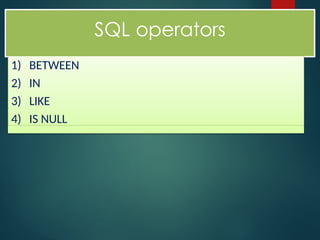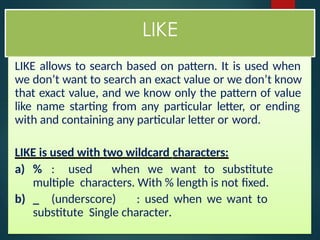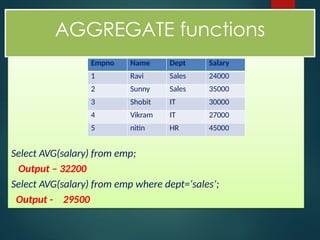Ad
SQL python for beginners easy explanation with concepts and output .pptx
- 1. SPRINGDALES SCHOOL DHAULA KUAN COMPUTER SCIENCE STD.XII
- 3. SQL – Structured Query Language Is a language that enables you to create and operate on relational databases It is the standard language used by almost all the database s/w vendors. Pronounced as SEQUEL Original version was developed by IBM’s Almanden Research Center Latest ISO standard of SQL was released in 2008 and named as SQL:2008
- 4. SQL –features Allows creating/modifying a database’s structure Changing security settings for system Permitting users for working on databases or tables Querying database Inserting/modifying/deleting the database contents
- 5. MYSQL Elements Literals Data types Nulls Comments
- 6. Literals It means the fixed value or constant value. It may be of character, numeric or date time type. Character and date/time literals are always in single quotation marks whereas numeric literals must be without single quotation marks For example – ‘Virat’, 12, 12.56, ‘04-20-2018’ format Date and time values are always in the YYYY-MM-DD HH:MI:SS Special character like quotes are always written be preceding it back-slash(). For example if we want to store value as Tom’s Cat then it should be written as Tom’s Cat
- 7. Data Type Means the type of value and type of operation we can perform on data. For example on numeric value we can store numbers and perform all arithmetic operations and so on. MySQL support three categories of data types: Numeric Date and time String types
- 8. Numeric Data Types Data type Description INT Numbers without decimal. Store up to 11 digits. -2147483648 to 2147483647 TINYINT Small integer value between 0 – 255 (4 digits) SMALLINT More than TINYINT between -32768 to 32767 (5 digit) MEDIUMINT Integer values up to 9 digits BIGINT Very large integer value up to 11 digits FLOAT(M,D) Real numbers i.e. number with decimal. M specify length of numeric value including decimal place D and decimal symbol. For example if it is given as FLOAT(8,2) then 5 integer value 1 decimal symbol and 2 digit after decimal TOTAL – 8. it can work on 24 digits after decimal. DOUBLE(M,D) Real numbers with more precision up to 53 place after decimal. DECIMAL It is used to store exact numeric value that preserve exact precision for e.g. money data in accounting system. DECIMAL(P,D) means P no. of significant digits (1-65), D represent no. of digit after decimal(0-30), for e.g DECIMAL(6,2) means 4 digit before decimal and 2 digit after decimal. Max will be 9999.99
- 9. Date and Time Types Data type Description DATE A date in YYY-MM-DD format between 1000-01-01 to 9999-12-31 In oracle data format is DD-MON-YYYY for e.g 10-SEP-2019 DATETIME Combination of date and time. For example to store 4th December 2018 and time is afternoon 3:30 then it should be written as – 2018-12-04 15:30:00 TIMESTAMP Similar to DATATIME but it is written without hyphen for example the above date time is stored as 20181204153000 TIME To store time in the format HH:MM:SS YEAR(M) To store only year part of data where M may be 2 or 4 i.e. year in 2 digit like 18 or 4 digit like 2018
- 10. String Types Data type Description CHAR(M) Fixed length string between 1 and 255. it always occupy M size for each data for example if size is CHAR(20) and we store value ‘MOBILE’ , although the size of MOBILE is 6 but in a table it will occupy 20 size with space padded at right side for remaining place. Mostly use in the case where the data to be insert is of fixed size like Grade (A,B,C,..) or Employee code as E001, E002, etc. In this case CHAR will give better performance than varchar VARCHAR(M) Variable length string between 1 and 65535 (from MySQL 5.0.3) , earlier it was 255. it takes size as per the data entered for example with VARCHAR(20) if the data entered is MOBILE then it will take only 6 byte. It is useful for the data like name, address where the number of character to be enter is not fixed. VARCHAR2 It is supported in ORACLE, both are almost same with minor difference. The difference is in the way they are handling Empty String and NULL, for VARCHAR these two are different where as VARCHAR2 treats both same.
- 11. Difference between CHAR & VARCHAR CHAR VARCHAR Fixed length string Variable length string Used where number of character to enter is fixed like Grade, EmpCode, etc Used where number of character to be enter is not fixed like name, address etc. Fast, no memory allocation every time Slow, as it take size according to data so every time memory allocation is done It takes more memory It takes less space
- 12. NULL VALUE • NULL means missing information • NULL can appear in any type of column if it is not restricted by NOT NULL or PRIMARY KEY • Always remember NULL is neither equal to 0 nor space. NULL means nothing • Used in situation like if email id is not available with students then we will insert NULL
- 13. COMMENTS • It is a text that is not executed, only for documentation purpose. Comments in MySQL can be written as – Begin the comment with /* and */ – Begin the comment with – (followed by space) – Begin then comment with # • For example – /* Select * from emp where empno=4 */ – Select * from emp; -- it will fetch all details
- 14. SQL COMMAND SYNTAX Commands Description Keywords That have special meaning in SQL. They are the commands in mysql Clause They are used to support mysql commands like FROM, WHERE etc. Arguments Values passed to clause like table name to FROM clause conditions to WHERE clause for e.g. SELECT * FROM EMP WHERE SALARY>12000; In the above command SELECT is keyword FROM AND WHERE is clause EMP is an argument to FROM SALARY>12000 is argument to WHERE
- 15. CREATING and USING DATABASE CREATE DATABASE <DATABASE NAME> CREATE DATABASE MYDB; TO SEE LIST OF DATABASES: SHOW DATABASES; TO OPEN ANY DATABASE TO WORK USE DATABASENAME; USE MYDB;
- 16. TABLE CONSTRAINTS 1. Primary Key Constraint 2. Unique Constraint 3. Check Constraint 4. Default Constraint 5. NOT NULL Constraint
- 17. Difference between Primary Key and Unique Constraint Primary Key Constraint Unique Constraint There is only one Primary key There can be more than one NULL values are not possible NULL values are possible
- 18. CREATING TABLE datatype(size), Syntax:- Create Table TableName(ColumnName ColumnName datatype(size),…..); Example:- Create Table Employee(empno int primary key, name varchar(20), dept varchar(20), salary int); Create table Student(roll int, name varchar(20), stream varchar(20), per int);
- 19. CREATING TABLE Create Table Employee(empno int primary key, name varchar(20), dept varchar(20), salary int); Empno Name Dept Salary 1 Ravi Sales 24000 2 Sunny Sales 35000 3 Shobit IT 30000 4 Vikram IT 27000 5 nitin HR 45000 6 Krish HR
- 20. SHOWING TABLE TO SEE LIST OF TABLES IN THE DATABASE SHOW TABLES;
- 21. SHOWING TABLE STRUCTURE TO SEE STRUCTURE OF TABLE: It specifies the fields, data types and constraints used in the table. DESC TABLENAME; OR DESCRIBE TABLENAME; EXAMPLE: DESC EMPLOYEE; DESC STUDENT;
- 22. MySQL allows us to get the structure of table like list of columns, data type, size and key information of table using DESC / DESCRIBE command Example
- 23. INSERTING RECORDS IN TABLE Syntax:- Insert into tablename values(value1,value2,…) Note:- 1) char, varchar and date value must be in single quotes 2) Values must be passed in the order of their column 3) Date values are passed in the format yyyy-mm-dd (in mysql)
- 24. INSERTING RECORDS IN TABLE Syntax:- Insert into emp values(1, ‘Ravi’,’Sales’,24000) Insert into student values(1,’Mahi’,’Science’,89); Inserting in selected columns Insert into emp (empno, name, dept ) values (2,’dipanker’,’IT’)
- 25. INSERTING RECORDS IN TABLE Syntax:- Insert into emp values(1, ‘Ravi’,’Sales’,24000); Empno Name Dept Salary 1 Ravi Sales 24000 2 Sunny Sales 35000 3 Shobit IT 30000 4 Vikram IT 27000 5 nitin HR 45000 6 Krish HR
- 26. SELECTING RECORD Select statement allows to send queries to table and fetch the desired record. Select can be used to select both horizontal and vertical subset. Syntax:- Select * / columnnames FROM tablename [ where condition ];
- 27. SELECTING RECORD Selecting all record and all columns Select * from emp; Selecting desired columns select empno, name from emp; Changing the order of columns select dept, name from emp;
- 28. SELECTING RECORD Selecting all record and all columns Select * from emp; Empno Name Dept Salary 1 Ravi Sales 24000 2 Sunny Sales 35000 3 Shobit IT 30000 4 Vikram IT 27000 5 nitin HR 45000 6 Krish HR
- 29. SELECTING RECORD Selecting desired columns select empno, name from emp; Empno Name 1 Ravi 2 Sunny 3 Shobit 4 Vikram 5 nitin 6 Krish
- 30. ALL keyword ALL keyword is used to see the duplicate records from output For e.g. if we select dept from employee table it will display all the department from the table including duplicate rows. ALL is the default , so using it is optional. Select ALL dept from emp; Output will be:- Dept -------- Sale Sale IT IT HR Empno Name Dept Salary 1 Ravi Sale 24000 2 Sunny Sale 35000 3 Shobit IT 30000 4 Vikram IT 27000 5 nitin HR 45000
- 31. DISTINCT keyword DISTINCT keyword is used to eliminate the duplicate records from output. If we don’t want to see the duplicate rows in output we have to use DISTINCT keyword. Select DISTINCT dept from emp; Output will be:- Dept -------- Sale IT HR Empno Name Dept Salary 1 Ravi Sale 24000 2 Sunny Sale 35000 3 Shobit IT 30000 4 Vikram IT 27000 5 nitin HR 45000
- 32. PERFORMING SIMPLE CALCULATION While performing SQL operations sometimes simple calculations are required, SQL provides facility to perform simple arithmetic operations in query. In MySQL we can give these queries without FROM clause i.e. table name is not required for these queries, For Example: Select 10*2; Select 10*3/6;
- 33. PERFORMING SIMPLE CALCULATION MySQL also provides DUAL table to provide compatibility with other DBMS. It is dummy table used for these type queries where table name is not required. It contains one row and one column. For example: Select 100+200 from DUAL; Select curdate( ) from dual; CALCULATION WITH TABLE DATA Select name, salary, salary * 12 Annual_Salary from emp; Select empno, salary+1000 from emp; Update student set total=phy+chem+maths+cs+eng;
- 34. COLUMN ALIAS It is a temporary name/label given to column that will appear in output. For example if column name is dept and you want Department to appear as column heading then we have to give Column Alias. If we want alias name of multiple words then it should be enclosed in double quotes. Its format is : ColumnName [AS] ColumnAlias Example (i)Select empno Employee_Number, name, dept Department, Salary Income from emp; (ii) Select name, Salary*12 as “Annual Income” from emp;
- 35. HANDLING NULL VINOD KUMAR VERMA, PGT(CS), KV OEF KANPUR & SACHIN BHARDWAJ, PGT(CS), KV NO.1 TEZPUR From the above table we can observe that salary of Shaban is NULL i.e. not assigned, Now if we want 0 or “not assigned” for the salary information of shaban, we have to use IFNULL() Select empno,name,IFNULL(Salary,”not assigned”) from emp; Column value to substitute if NULL found
- 36. PUTTING TEXT IN QUERY OUTPUT SQL allows to put user defined symbols or text with table output. Like ‘Rs’ with Salary or ‘%’ symbol with commission For e.g. Select name, dept, ‘Rs.’, salary from emp; Select name, ‘ works in department’, dept, ‘ and getting salary rs. ‘, salary from emp; Select name, concat(‘Rs. ‘, salary) from emp;
- 37. WHERE clause WHERE clause is used to select specified rows. It allows to select only desired rows by applying condition. We can use all comparison(>, <, >=, <=, =, <>) and logical operator (AND, OR, NOT). AND ( &&), OR (||) , NOT (!) For example Select * from emp where salary>4000; Select * from emp where empno=1; Select name,dept from emp where dept=‘HR’;
- 38. WHERE clause Selecting desired columns and rows: select empno, name from emp where Empno=2; Empno Name 2 Sunny
- 39. WHERE clause AND(&&) means both conditions must be true, OR(||) means any condition must be true to produce output. NOT(!) will do the reverse checking. Select * from emp where salary>4000 and salary<8000; Select * from emp where dept=‘Sales’ and salary<30000; Select name,dept from emp where dept=‘HR’ and salary>=20000 and salary<=40000; Select * from emp where dept=‘HR’ or dept=‘IT’; Select * from emp where NOT empno=4;
- 40. WHERE clause Select * from emp where dept=‘Sale’ and salary<30000; Empno Name Dept Salary 1 Ravi Sale 24000
- 41. SQL operators 1) BETWEEN 2) IN 3) LIKE 4) IS NULL
- 42. BETWEEN BETWEEN allows to specify range of values to search in any column. It is used with AND clause and it will include the specified values during the searching. For e.g. Select * from emp where salary between 18000 and 30000; Select name from emp where empno between 2 and 5; Select * from emp where salary NOT between 25000 and 35000;
- 43. BETWEEN Select * from emp where salary between 18000 and 30000; OR Select * from emp where salary >= 18000 AND salary <= 30000; Empno Name Dept Salary 1 Ravi Sale 24000 3 Shobit IT 30000 4 Vikram IT 27000
- 44. IN IN allows to specify LIST of values in which searching will be performed. It will return all those record that matches any value in a given list of values. It can be thought as an alternative of multiple ORs Select * from emp where dept IN(‘sales’,’it’); Select name from emp where empno IN (2,4,5); Select * from emp where dept NOT IN(‘sales’,’it’)
- 45. IN Select * from emp where dept IN(‘sales’,’it’); OR Select * from emp where dept =‘sales’ OR dept=’it’; Empno Name Dept Salary 1 Ravi Sale 24000 2 Sunny Sale 35000 3 Shobit IT 30000 4 Vikram IT 27000
- 46. LIKE LIKE allows to search based on pattern. It is used when we don’t want to search an exact value or we don’t know that exact value, and we know only the pattern of value like name starting from any particular letter, or ending with and containing any particular letter or word. LIKE is used with two wildcard characters: a) % : used when we want to substitute multiple characters. With % length is not fixed. b) _ (underscore) : used when we want to substitute Single character.
- 47. LIKE Search for employee whose name begins from ‘S’ Select * from emp where name like ‘S%’; Search for employee whose name ends with ‘r’ Select * from emp where name like ‘%r’; Search for employee whose name contains ‘a’ anywhere Select * from emp where name like ‘%a%’ Search for employee whose dob is in feb(dd-mm-yy) Select * from emp where dob like ‘%-02-%’ Search employee whose name is of 5 letters begins from ‘s’ Select * from emp where name like ‘s_ _ _ _ ’;
- 48. LIKE Search for employee whose name begins from ‘s’ Select * from emp where name like ‘S%’; Empno Name Dept Salary 2 Sunny Sale 35000 3 Shobit IT 30000
- 49. IS NULL IS NULL is used to compare NULL values present in any column. Because NULL is not considered as value so we cannot compare with = sign, so to compare with NULL , SQL provides IS NULL. Select * from emp where salary is null; Select * from emp where salary is not null;
- 50. SORTING OUTPUT By default records will come in the output in the same order in which it was entered. To see the output rows in sorted or arranged in ascending or descending order ,SQL provide ORDER BY clause. By default output will be ascending order(ASC) to see output in descending order we use DESC clause with ORDER BY. Select * from emp order by name; (ascending order) Select * from emp order by salary desc; (descending order) Select * from emp order by dept asc, salary desc;
- 51. SORTING OUTPUT Select * from emp order by salary desc; Empno Name Dept Salary 5 nitin HR 45000 2 Sunny Sale 35000 3 Shobit IT 30000 4 Vikram IT 27000 1 Ravi Sale 24000
- 52. JUST A MINUTE… • Create the following table and add the records in ITEMS table: ItemNo Item Dcode Qty UnitPrice StockDate 5005 Ball Pen 0.5 102 100 16 2018-03-10 5003 Ball Pen 0.25 102 150 20 2017-05-17 5002 Gel Pen Premium 101 125 14 2018-04-20 5006 Gel Pen Classic 101 200 22 2018-10-08 5001 Eraser Small 102 210 5 2018-03-11 5004 Eraser Big 102 60 10 2017-11-18 5009 Sharpener Classic NULL 160 8 2017-06-12
- 53. JUST A MINUTE… Write down the following queries based on the given table: 1) Select all record of table 2) Select ItemNo, name and Unitprice 3) Select all item record where Unitprice is more than 20 4) Select Item name of those items which are quantity between 100-200 5) Select all record of Items which contains ‘pen‘ word in it 6) Select unique dcode of all items 7) Display all record in the descending order of UnitPrice
- 54. OPERATOR PRECEDENCE When multiple operators are used in expression, then evaluation of expression takes place in the order of precedence. Higher precedence operator will execute first. ! *, /, DIV, %, MOD - + <, > ==, >=, <=, !=, IS, LIKE, IN, BETWEEN NOT AND OR HIGH LOW
- 55. AGGREGATE functions Aggregate function is used to perform calculation on group of rows and return the calculated summary like sum of salary, average of salary etc. Available aggregate functions are – 1. SUM() 2. AVG() 3. COUNT() 4. MAX() 5. MIN() 6. COUNT(*)
- 56. AGGREGATE functions Select SUM(salary) from emp; Output – 161000 Select SUM(salary) from emp where dept=‘sales’; Output - 59000 Empno Name Dept Salary 1 Ravi Sales 24000 2 Sunny Sales 35000 3 Shobit IT 30000 4 Vikram IT 27000 5 nitin HR 45000
- 57. AGGREGATE functions Select AVG(salary) from emp; Output – 32200 Select AVG(salary) from emp where dept=‘sales’; Output - 29500 Empno Name Dept Salary 1 Ravi Sales 24000 2 Sunny Sales 35000 3 Shobit IT 30000 4 Vikram IT 27000 5 nitin HR 45000
- 58. AGGREGATE functions Select COUNT(name) from emp; Output – 5 Select COUNT(salary) from emp where dept=‘HR’; Output - 1 Select COUNT(DISTINCT dept) from emp; Output - 3 Empno Name Dept Salary 1 Ravi Sales 24000 2 Sunny Sales 35000 3 Shobit IT 30000 4 Vikram IT 27000 5 nitin HR 45000
- 59. AGGREGATE functions Select MAX(Salary) from emp; Output – 45000 Select MAX(salary) from emp where dept=‘Sales’; Output - 35000 Empno Name Dept Salary 1 Ravi Sales 24000 2 Sunny Sales 35000 3 Shobit IT 30000 4 Vikram IT 27000 5 nitin HR 45000
- 60. AGGREGATE functions Select MIN(Salary) from emp; Output – 24000 Select MIN(salary) from emp where dept=‘IT’; Output - 27000 Empno Name Dept Salary 1 Ravi Sales 24000 2 Sunny Sales 35000 3 Shobit IT 30000 4 Vikram IT 27000 5 nitin HR 45000
- 61. AGGREGATE functions Select COUNT(*) from emp; Output – 6 Select COUNT(salary) from emp; Output - 5 Empno Name Dept Salary 1 Ravi Sales 24000 2 Sunny Sales 35000 3 Shobit IT 30000 4 Vikram IT 27000 5 nitin HR 45000 6 Krish HR
- 62. count(*) Vs count() Count(*) function is used to count the number of rows in query output whereas count() is used to count values present in any column excluding NULL values. Note: All aggregate function ignores the NULL values. Give previous example.
- 63. GROUP BY GROUP BY clause is used to divide the table into logical groups and we can perform aggregate functions in those groups. In this case aggregate function will return output for each group. For example if we want sum of salary of each department we have to divide table records.
- 64. Aggregate functions by default takes the entire table as a single group that’s why we are getting the sum(), avg(), etc output for the entire table. Now suppose organization wants the sum() of all the job separately, or wants to find the average salary of every job. In this case we have to logically divide our table into groups based on job, so that every group will be passed to aggregate function for calculation and aggregate function will return the result for every group.
- 65. column value. In those logically divided records we can apply aggregate functions. For. E.g. SELECT SUM(SAL) FROM EMP GROUP BY DEPT; SELECT JOB,SUM(SAL) FROM EMP GROUP BY DEPT; SELECT JOB,SUM(SAL),AVG(SAL),MAX(SAL),COUNT(*) EMPLOYEE_COUNT FROM EMP; NOTE :- when we are using GROUP BY we can use only aggregate function and the column on which we are grouping in the SELECT list because they will form a group other than any column will gives you an error because they will be not the part of the group. For e.g. SELECT ENAME,JOB,SUM(SAL) FROM EMP GROUP BY JOB; Error -> because Ename is not a group expression Group by clause helps up to divide the table into logical groups based
- 66. HAVING with GROUP BY • If we want to filter or restrict some rows from the output produced by GROUP BY then we use HAVING clause. It is used to put condition of group of rows. With having clause we can use aggregate functions also. • WHERE is used before the GROUP BY. With WHERE we cannot use aggregate function. • E.g. • SELECT DEPT,AVG(SAL) FROM EMP GROUP BY DEPT HAVING DEPT IN (‘HR’,’SALES’) • SELECT DEPT,MAX(SAL),MIN(SAL),COUNT(*) FROM EMP GROUP BY DEPT HAVING COUNT(*)>1 • SELECT DEPT,MAX(SAL),MIN(SAL) FROM EMP WHERE SAL>=2000 GROUP BY DEPT HAVING DEPT IN(‘IT’,’HR’)
- 67. JUST A MINUTE… • Create the following table and add the records ItemNo Item Dcode Qty UnitPrice StockDate 5005 Ball Pen 0.5 102 100 16 2018-03-10 5003 Ball Pen 0.25 102 150 20 2017-05-17 5002 Gel Pen Premium 101 125 14 2018-04-20 5006 Gel Pen Classic 101 200 22 2018-10-08 5001 Eraser Small 102 210 5 2018-03-11 5004 Eraser Big 102 60 10 2017-11-18 5009 Sharpener Classic NULL 160 8 2017-06-12
- 68. JUST A MINUTE… Write down the following queries based on the given table: 1. Change the unitprice to 20 for itemno 5005 2. Delete the record of itemno 5001 3. Display all the item name in capital letters 4. Display first 4 character of every item name 5. Display all record whose dcode is not assigned 6. Display all items which are stocked in the month of March
- 69. MYSQL FUNCTIONS A function is built – in code for specific purpose that takes value and returns a single value. Values passed to functions are known as arguments/parameters. There are various categories of function in MySQL:- 1) String Function 2) Mathematical function 3) Date and time function
- 70. String Function Function Description Example ASCII( ) Returns the ASCII value of the character Select ascii(‘A’); Output- 65 CHAR( ) Return character for given ASCII Code Select char(65); Output- A CONCAT( ) Return concatenated string Select concat(name, ‘ works in ‘, dept,’ department); LOWER()/ LCASE( ) Return string in small letters Select lower(‘INDIA’); Output- india Select lower(name) from emp; SUBSTRING( S,P,N) / MID(S,P,N) Return N character of string S, beginning from P Select SUBSTRING(‘LAPTOP’,3,3); Output – PTO Select SUBSTR(‘COMPUTER’,4,3); Output – PUT UPPER()/ UCASE( ) Return string in capital letters Select Upper(‘india’); Output- INDIA LTRIM( ) Removes leading space Select LTRIM(‘Apple’); Output- ‘Apple’
- 71. String Function Function Description Example TRIM() Remove spaces from beginning and ending Select TRIM(‘ Apple ‘); Output-’Apple’ Select * from emp where trim(name) = ‘Suyash’; INSTR() It search one string in another string and returns position, if not found 0 Select INSTR(‘COMPUTER’,’PUT’); Output-4 Select INSTR(‘PYTHON’,’C++’); Output – 0 LENGTH() Returns number of character in string Select length(‘python’); Output- 7 Select name, length(name) from emp LEFT(S,N) Return N characters of S from beginning Select LEFT(‘KV OEF’,2); Output- KV RIGHT(S,N) Return N characters of S from ending Select RIGHT(‘KV OEF’,3); Output- OEF
- 72. Numeric Function Function Description Example MOD(M,N) Return remainder M/N Select MOD(11,5); Output- 1 POWER(B,P) Return B to power P Select POWER(2,5); Output-32 ROUND(N,D) Return number rounded to D place after decimal Select ROUND(11.589,2); Output- 11.59 Select ROUND(12.999,2); Output- 13.00 SIGN(N) Return -1 for –ve number 1 for +ve number Select sign(-10); Output : -1 Select sign(10); Output : 1 SQRT(N) Returns square root of N Select SQRT(144); Output: 12 TRUNCATE( M,N) Return number upto N place after decimal without rounding it Select Truncate(15.789,2); Output: 15.79
- 73. Date and Time Function VINOD KUMAR VERMA, PGT(CS), KV OEF KANPUR & SACHIN BHARDWAJ, PGT(CS), KV NO.1 TEZPUR Function Description Example CURDATE( )/ CURRENT_DATE( ) / CURRENT_DATE Return the current date Select curdate(); Select current_date(); DATE() Return date part from date- time expression Select date(‘2018-08-15 12:30’); Output: 2018-08-15 MONTH() Return month from date Select month(‘2018-08-15’); Output: 08 YEAR() Return year from date Select year(‘2018-08-15’); Output: 2018 DAYNAME() Return weekday name Select dayname(‘2018-12-04’); Output: Tuesday DAYOFMONTH() Return value from 1-31 Select dayofmonth(‘2018-08-15’) Output: 15 DAYOFWEEK() Return weekday index, for Sunday-1, Monday-2, .. Select dayofweek(‘2018-12-04’); Output: 3 DAYOFYEAR() Return value from 1-366 Select dayofyear(‘2018-02-10’) Output: 41
- 74. Date and Time Function Function Description Example NOW() Return both current date and time at which the function executes Select now(); SYSDATE() Return both current date and time Select sysdate() Difference Between NOW() and SYSDATE() : NOW() function return the date and time at which function was executed even if we execute multiple NOW() function with select. whereas SYSDATE() will always return date and time at which each SYDATE() function started execution. For example. mysql> Select now(), sleep(2), now(); Output: 2018-12-04 10:26:20, 0, 2018-12-04 10:26:20 mysql> Select sysdate(), sleep(2), sysdate(); Output: 2018-12-04 10:27:08, 0, 2018-12-04 10:27:10
- 75. Class Assignment- PRACTICAL FILE Write SQL queries for I to vi and outputs for vii to ix. TABLE: VEHICLE VCODE VEHICLETYPE PERKM V01 VOLVO BUS 150 V02 AC DELUXE BUS 125 V03 ORDINARY BUS 80 V05 SUV 30 V04 CAR 18 TABLE: TRAVEL CNO CNAME TRAVELDATE KM VCODE NOP 101 K.Niwal 2015-12-13 200 V01 32 103 Fredrick Sym 2016-03-21 120 V03 45 105 Hitesh Jain 2016-04-23 450 V02 42 102 Ravi anish 2016-01-13 80 V02 40 107 John Malina 2015-02-10 65 V04 2
- 76. 1.To display CNO, CNAME, TRAVELDATE from the table TRAVEL in descending order of CNO. 2. To display the CNAME in uppercase of all the customers from the table TRAVEL who are travelling by vehicle with code V01 or V02. 3.To display the CNO and CNAME , month and Year of TRAVEL for all those who travelled between ‘2015-12-31’ and ‘2015-05-01’. 4. To add a new column status char(1) to the VEHICLE table. 5. To enter the value as ‘A’ for all Status values. 6. Delete Vehicletype CAR from Vehicle table. 7.SELECT Left(VEHICLETYPE,1) FROM VEHICLE; 8. SELECT A.VCODE,CNAME,VEHICLETYPE FROM TRAVEL A,VEHICLE B WHERE A.VCODE=B.VCODE AND PERKM<90; 9. SELECT CNAME,KM*PERKM FROM TRAVEL A, VEHICLE B WHERE A.VCODE=B.VCODE AND A.VCODE=‘V05’;
- 80. EXPORTING DATABASE • Exporting means creating the text file containing all the database contents which can be imported to any other computer. We use mysqldump command for this purpose. To export: • Open cmd from Start button Or • Press Window Key + R and type cmd and press Enter • Atcmd prompt like C:....> type mysqldump command
- 81. EXPORTING DATABASE • To export all database – mysqldump --all-databases > c:mydb.sql • It will create mydb.sql in C:, we can check it by open it. • To export single database – mysqldump myworks > c:mydb2.sql • To export multiple datbase – mysqldump myworks company c:mydb3.sql
- 82. IMPORTINGDATABASE • STEP – 1 – Open Notepad and type the following commands
- 83. IMPORTING DATABASE • STEP – 1 – Save this file with mydb.sql or any name, in your desired location for e.g. C: • STEP – 2 – Open MySQL and type • SOURCE C:mydb.sql – It will create database myworks, 2 tables emp, students with records. We can check it by “SHOW TABLES” or “SELECT” command



















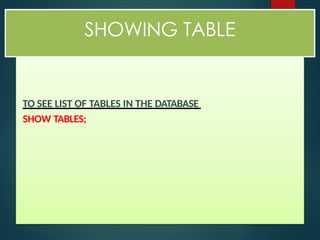


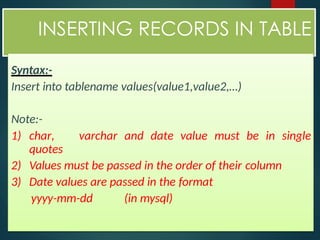


![SELECTING RECORD
Select statement allows to send queries to table and
fetch the desired record. Select can be used to select
both horizontal and vertical subset.
Syntax:-
Select * / columnnames FROM
tablename
[ where condition ];](https://image.slidesharecdn.com/2-241225040359-298dfa63/85/SQL-python-for-beginners-easy-explanation-with-concepts-and-output-pptx-26-320.jpg)







![COLUMN ALIAS
It is a temporary name/label given to column that will appear in
output. For example if column name is dept and you want
Department to appear as column heading then we have to give
Column Alias. If we want alias name of multiple words then it
should be enclosed in double quotes. Its format is :
ColumnName [AS] ColumnAlias
Example
(i)Select empno Employee_Number, name, dept Department,
Salary Income from emp;
(ii) Select name, Salary*12 as “Annual Income” from emp;](https://image.slidesharecdn.com/2-241225040359-298dfa63/85/SQL-python-for-beginners-easy-explanation-with-concepts-and-output-pptx-34-320.jpg)






